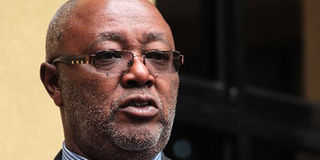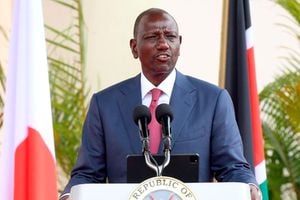Students snub diploma courses

John Muraguri, the chief executive officer of Kenya Universities and Colleges Central Placement Service, in Nairobi on August 5, 2015. PHOTO | JAMES EKWAM | NATION MEDIA GROUP
What you need to know:
- The Kenya Universities and Colleges Central Placement Service, the body charged with admitting students to public tertiary institutions, on Friday sais that only 12,038 candidates applied to join the 57 middle level colleges.
- This is despite the technical colleges having capacity of 49,528 slots and the government putting up more technical colleges across the country with a target of additional 130 colleges by the end of next year.
The majority of students who sat the Kenya Certificate of Secondary Education examination last year have snubbed diploma courses in government institutions.
The Kenya Universities and Colleges Central Placement Service (KUCCPS), the body charged with admitting students to public tertiary institutions, on Friday sais that only 12,038 candidates applied to join the 57 middle level colleges.
This is despite the technical colleges having capacity of 49,528 slots and the government putting up more technical colleges across the country with a target of additional 130 colleges by the end of next year.
A total of 165,766 candidates attained the minimum university entry qualification of C+ and above and 74,046 have been selected to join public universities.
Speaking during the fifth stakeholder’s workshop at Kenya Institute of Curriculum Development (KICD), KUCCPS Chief executive Officer John Muraguri blamed the low numbers to poor attitude towards the technical institutions.
Various stakeholders at the forum that includes vice-chancellors, their deputies and deans of schools asked the government to step up efforts to popularise courses offered in such colleges.
But Edwin Tarno, the chairman of Kenya Technical Training Institutions, accused universities of being a stumbling block to the growth of the Technical and Vocational Education and Training institutions (TVETs) as most of them have denied diploma graduates transition to universities.
“We are hear getting admission of students to universities and colleges because they sat for examination that was administered by Kenya National Examination Council (KNEC). However, when college students after three years sit for KNEC exams, universities deny them admission insisting that they should start from year one. This is unacceptable and we must change from there,” said Mr Tarno.
Private universities also raised concern over failure to allocate them government sponsored students.
However, Commission for University Education (CUE) Chief Executive Officer David Some announced that on Thursday, the government will provide procedures on the admission of 10,000 government sponsored students to private universities on a pilot basis.
Education Cabinet Secretary Fred Matiang’i observed that the ministry is cognisant of the need to promote access to TVET and create a favourable policy environment in consultation with other stakeholders to promote access to technical and vocational training.
Dr Matiang’i added that the rising demand for higher education had led to expansion of universities as more young Kenyans have an opportunity to access university or college education compared to 10 years ago.
“Even as we seek to help our young sons and daughters to access university education, we should not forget about the technical skills that are key in driving Kenya’s economy,” said Mr Matiang’i.
He lauded the merit-based placement process, saying that it ensured that young Kenyans are given equitable opportunities to access higher education while the disadvantaged benefit from affirmative action for gender, disabilities and marginalised counties.
Dr Matiang’i asked universities and colleges to play their respective roles in ensuring that they provide quality and affordable higher education to Kenyans.
Dr Matiang’i speech was read on his behalf by acting director of higher Education James Kibiru.
According to KUCCPS, placement policy and procedure provide for affirmative action for three categories: gender, disability and marginalised or minority groups.





